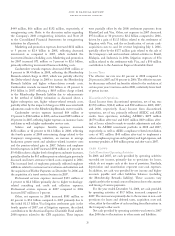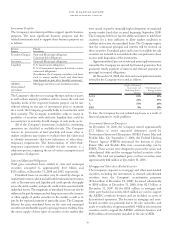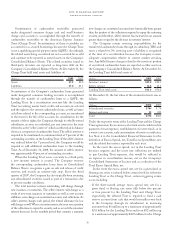American Express 2008 Annual Report Download - page 38
Download and view the complete annual report
Please find page 38 of the 2008 American Express annual report below. You can navigate through the pages in the report by either clicking on the pages listed below, or by using the keyword search tool below to find specific information within the annual report.
2008 financial review
american express company
In addition to increased borrowing costs, a decline in its long-
term credit rating could reduce its borrowing capacity in the
unsecured term debt capital markets, if and when such markets
become available. A downgrade of one level in the Company’s
short-term rating would result in the Company having to
significantly reduce (or eliminate) its outstanding commercial
paper compared to historical levels. In the event a reduction
in its borrowing capacity in the short-term debt markets were
to occur, the Company would further shift its funding to
other funding programs such as retail deposits, the issuance
of long-term debt, and asset securitization, to the extent these
markets are available.
short-term funding programs
Short-term borrowings, including commercial paper and
federal funds purchased, are defined as any debt or time deposit
with an original maturity of 12 months or less. The Company’s
short-term funding programs are used primarily to meet
working capital needs, such as managing seasonal variations in
receivables balances, and have not, on average, grown in size
with its business growth. The ultimate amount and mix issued
will depend on the Company’s needs and market conditions.
American Express Credit Corporation’s (Credco) commercial
paper is a principal source of short-term borrowings for
the Company. Centurion Bank and FSB raise short-term
borrowings through various instruments.
The Company had the following short-term borrowings
outstanding at December 31:
(Billions) 2008 2007
Credco:
Commercial paper $7.3 $10.5
Other 0.1 0.6
Centurion Bank and FSB:
Bank notes —2.9
Federal funds purchased 0.5 2.4
Other 1.1 1.4
Total $9.0 $17.8
The Company’s short-term borrowings as a percentage of total
debt at December 31 was as follows:
2008 2007
Short-term borrowings as a percentage
of total debt (GAAP basis) 13.0% 24.3%
The Company had continuous access to the commercial paper
market during 2008. Its commercial paper issuances after mid-
September occurred at shorter weighted average maturities
than the Company’s historic trend, consistent with the changes
in issuance maturities occurring across the overall commercial
paper market, as reported by the Federal Reserve.
On October 7, 2008, the Federal Reserve Board established
the Commercial Paper Funding Facility (CPFF). The CPFF
provides three month liquidity to U.S. issuers of commercial
paper through a special purpose vehicle (SPV), which purchases
three month unsecured and asset-backed commercial paper
directly from eligible issuers using financing provided by the
Federal Reserve Bank of New York. The commercial paper must
be rated at least A1/P1/F1 by a major nationally recognized
statistical rating organization (NRSRO) and, if rated by
multiple major NRSROs, must be rated at least A1/P1/F1/R1
(middle) by two or more NRSROs. Credco is eligible to have
up to $14.7 billion of commercial paper outstanding with the
SPV at any one time. The SPV is currently scheduled to cease
purchasing commercial paper on October 30, 2009, unless the
Board extends the facility. At December 31, 2008, the Company
had $7.3 billion of commercial paper outstanding, including
$4.5 billion under the CPFF.
Average commercial paper outstanding was $10.8 billion
and $7.8 billion in 2008 and 2007, respectively, including
amounts issued through the CPFF program. Credco currently
manages the level of short-term borrowings outstanding such
that its back-up liquidity, including available bank credit
facilities and cash and readily-marketable securities, are not less
than 100 percent of net short-term borrowings. Credco’s total
back-up liquidity coverage of net short-term borrowings was in
excess of 100 percent at December 31, 2008 and 2007.
deposit programs
Historically, the vast majority of deposits raised at Centurion
Bank and FSB came through the issuance of certificates
of deposit (CDs) to institutional investors in amounts that
exceeded the maximum amount of FDIC insurance. During
the fourth quarter of 2008, the Company significantly shifted
its deposit-gathering activities from institutional to individual
deposits in which the amounts are fully covered by FDIC
deposit insurance. Institutional CDs were subject to many of
the same factors that have affected the unsecured debt and asset
securitization markets, and investors reduced their demand for
CDs during the fourth quarter of 2008.
As part of its continuing objective to target broad and
diversified sources of funding, the Company sought to increase
its funding sources directed to individual investors. During
2008 the Company launched a retail CD program through the
Banks. These CDs are offered to individual, retail depositors in
amounts that fully qualify for FDIC insurance protection. The
Company’s deposits are currently gathered through distribution
arrangements with other firms providing brokerage and
investment services to individuals. The Company believes it
can use the American Express brand name to expand its deposit
base as a key source of funding and is pursuing a number of
strategies to raise additional deposits, including offering retail
deposits directly to the consumers.
36
























